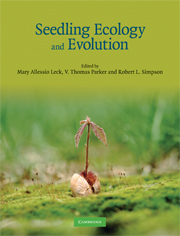Book contents
- Frontmatter
- Contents
- Contributors
- Foreword by Peter J. Grubb
- Preface
- Acknowledgments
- Part I Introduction
- Part II Seedling diversity
- Part III Seedling morphology, evolution, and physiology
- Part IV Life history implications
- Chapter 10 The seedling as part of a plant's life history strategy
- Chapter 11 Seedling recruitment and population ecology
- Chapter 12 Seedling communities
- Chapter 13 Spatial variation in seedling emergence and establishment – functional groups among and within habitats?
- Part V Applications
- Part VI Synthesis
- References
- Index
Chapter 11 - Seedling recruitment and population ecology
Published online by Cambridge University Press: 05 June 2012
- Frontmatter
- Contents
- Contributors
- Foreword by Peter J. Grubb
- Preface
- Acknowledgments
- Part I Introduction
- Part II Seedling diversity
- Part III Seedling morphology, evolution, and physiology
- Part IV Life history implications
- Chapter 10 The seedling as part of a plant's life history strategy
- Chapter 11 Seedling recruitment and population ecology
- Chapter 12 Seedling communities
- Chapter 13 Spatial variation in seedling emergence and establishment – functional groups among and within habitats?
- Part V Applications
- Part VI Synthesis
- References
- Index
Summary
Introduction
In plant population ecology, recruitment refers to the process by which new individuals found a population or are added to an existing population. Although recruitment may refer to clonal offspring, by far the most common means of recruitment is by seedlings. Seedling recruitment includes three basic processes: seed germination, seedling survivorship, and seedling growth. Seedlings represent the interface between the seed and the developing plant, and as a transitional life cycle stage, it has been difficult to define unambiguously when a seedling stops being a seedling (Kitajima & Fenner, 2000). Population studies often define seedlings somewhat arbitrarily, implying also that population processes such as seedling recruitment may be assessed arbitrarily. Irrespective of the definition, it is clear that the seedling stage represents the most sensitive part of the plant life cycle (Harper, 1977; Silvertown & Charlesworth, 2001). Seedlings are usually small and vulnerable to various abiotic and biotic agents. They often have only a tiny supply of resources to consume before they must exploit external resources in competition with other plants. Thus, seedlings are commonly subject to the highest mortality rates of any stage in the plant life cycle.
Seedling recruitment varies widely across species and communities. A stable population is maintained if one reproductive individual is replaced, on average, by one successfully recruited offspring. Therefore, we expect that there is a relationship between the life span of the plants and the temporal pattern of seedling recruitment.
- Type
- Chapter
- Information
- Seedling Ecology and Evolution , pp. 239 - 254Publisher: Cambridge University PressPrint publication year: 2008
- 30
- Cited by



